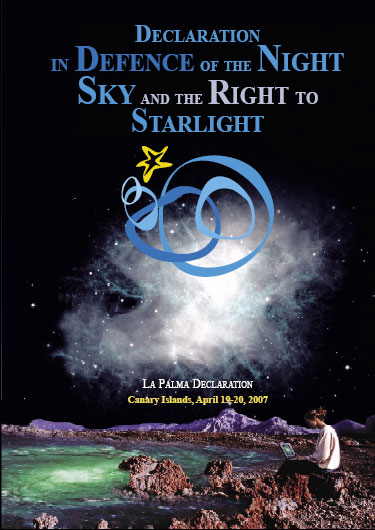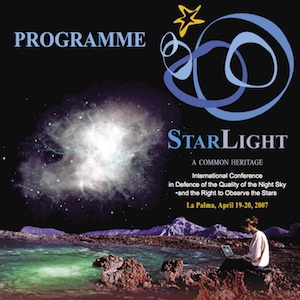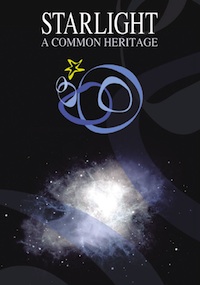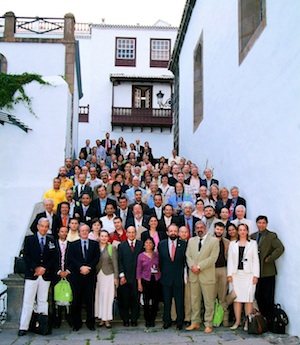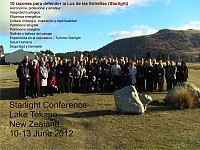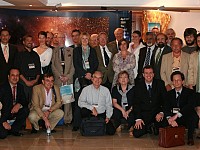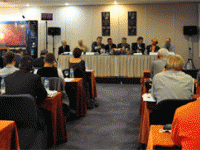Primera Conferencia Starlight en 2007
World Conference in Defence of the Night Sky and the Right to Observe the Stars
The initial result of the Conference was the La Palma Declaration, or World Declaration on the Right to Starlight that set a genuine world policy in its ten sections, based on principals and objectives that had been adopted by common consent. The Conference also adopted a set of final Resolutions and an Additional Resolution concerning the creation the Scientific Committee.
The Conference had a Committee of Honour chaired by His Royal Highness the Prince of Asturias and an Organising Committee, Main Rapporteurs and the permanent advice of the Scientific Committee chaired by Professor Jafar Jafari, of the University of Wisconsin.
People from 26 countries took part in the Conference. There were 10 international governmental organisations and 5 non governmental organisations. In total, 109 institutions took direct or indirect part in the process of the Conference.During the Conference, 71 communications were presented, 21 lectures were given; 11 parallel conferences were organised, together with 12 exhibitions and 13 poster presentations.
Juan Antonio Menéndez Pidal, Secretary General of the Conference
Honorary Board
TERRESTRIAL OUTREACH - Living the Stardome on Earth
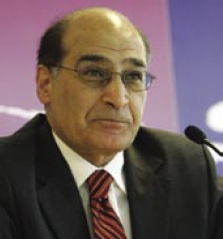
A number of factors make StarLight: A Common Heritage a remarkable vision, a supra-worldview. In April 2007, individuals and representatives from diverse academic and operational fields, from hard and social sciences, and from government and nongovernmental agencies and institutions gathered in La Palma, Spain, to spark the StarLight “territory”: majestically domed under the skyscape, as seen from the earthscape.
StarLight is a farsighted terrestrial outreach: to unite the already impoverished earth with its relatively undisturbed heritage above, viewable dimly and superficially during the night. Understanding this whole—the earthscape, the skyscape, and all that is encapsulated in between—is indeed an uplifting visionary mission, significantly overarching and surpassing the new Live Earth movement, whose concerns are mainly earthbound...
Jafar Jafari, Chair, StarLight Scientific Committee, University of Wisconsin- Stout. USA.
A planetary awareness
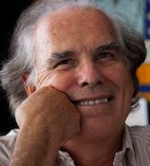 To be able to contemplate the starry skies at night without the polluted fog of artificial lights masking the countless shining pinheads dotted over the heavens and, as a result, enjoy the night sky is a marvel that escapes an increasing number of people. Yet this is something that we all deserve and probably need. This thinking, curious and exploring species to which we belong has evolved by gazing at the heavens and by questioning. We recognise that what we are is written above, up there in the mysterious universe that palpitates spectacularly, as poets and wise men have always maintained. All cultures have been interested in knowing what we are, where we come from and where we are going; and astrophysics approaches such important questions using slow, but sure scientific methods.
To be able to contemplate the starry skies at night without the polluted fog of artificial lights masking the countless shining pinheads dotted over the heavens and, as a result, enjoy the night sky is a marvel that escapes an increasing number of people. Yet this is something that we all deserve and probably need. This thinking, curious and exploring species to which we belong has evolved by gazing at the heavens and by questioning. We recognise that what we are is written above, up there in the mysterious universe that palpitates spectacularly, as poets and wise men have always maintained. All cultures have been interested in knowing what we are, where we come from and where we are going; and astrophysics approaches such important questions using slow, but sure scientific methods.
... the aim is to contribute to the creation of planetary awareness and to encourage humans—all space travellers from this planet called Earth—to reach a common planetary commitment to preserve the Earth from the serious damage that we ourselves are inflicting upon it.
Francisco Sánchez, Director of the Isntituto de Astrofísica de Canarias.
Defend our right to see the stars
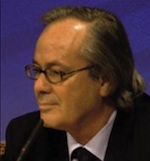 The sky, our common and universal heritage, is an integral part of the environment perceived by humanity, as it was perfectly outlined in the document of Proclamation of 2009 as International Year of Astronomy, presented in 2005 at the 33rd Session of the UNESCO General Conference: “Humankind has always observed the sky either to interpret it or to understand the physical laws that govern the universe. This interest in astronomy has had profound implications for science, philosophy, religion, culture and our general conception of the universe”. Still its contemplation is increasingly difficult to the point that it is becoming unknown for new generations. An essential element of our civilization and culture that we are losing at a fast pace, and whose loss would affect all countries in the world.
The sky, our common and universal heritage, is an integral part of the environment perceived by humanity, as it was perfectly outlined in the document of Proclamation of 2009 as International Year of Astronomy, presented in 2005 at the 33rd Session of the UNESCO General Conference: “Humankind has always observed the sky either to interpret it or to understand the physical laws that govern the universe. This interest in astronomy has had profound implications for science, philosophy, religion, culture and our general conception of the universe”. Still its contemplation is increasingly difficult to the point that it is becoming unknown for new generations. An essential element of our civilization and culture that we are losing at a fast pace, and whose loss would affect all countries in the world.
Since the oldest ages, night sky observation was a basic dimension in all cultures worldwide. From Aristotle to Galileo, from Ur to Mesa Verde, astronomy has marked the pace of science history and of the cultural perception of the world. Several peoples’ identities were based on cultural expressions related with stars. Major exploration and trade routes have been traced using stars as references. But we are nowadays facing a new situation, where we risk limiting our astronomical culture to a closed and threatened area only available to few researchers in distant technological spheres. Nevertheless, the study of astronomy allowed humankind creating calendars, navigating offshore through sky mapping, making substantial changes in science as a transversal language. Today as yesterday, night skies are able to wake up our imagination and help us finding our place in the cosmos. “We are children of clay, but also of the starry sky” is an ancient Nahuatl saying that definitely resumes this perception.
Cipriano Marín. Coordinator of the Starlight Initiative
Other related Starlight conferences
Lago Tekapo - Nueva Zelanda - 11,12 y 13 de Junio de 2012
whiti mai ngā whetū
...
Seminario y Reunión Internacional de Expertos
Fuerteventura (Islas Canarias), 10-11 Marzo
...
Seminario Internacional y Reunión de Expertos
La Palma (Islas Canarias), 9-10 Noviembre
...
| < Anterior |
|---|
Sessions of the Starlight Conference 2007
¿BUSCANDO ESTRELLAS?


Entidad colaboradora del PORTAL DEL PATRIMONIO ASTRONÓMICO

Novedades
- Nueva publicación de la Iniciativa Starlight en asociación con UNESCO-MaB - Con el apoyo de iGuzzini
- El Parlamento de Galicia adopta la Declaración Starlight
- La Iniciativa Starlight en la 39ª Sesión del Comité del Patrimonio Mundial
- Declaración Internacional advierte sobre los riesgos de la luz blanca
- Nueva publicación de la Iniciativa Starlight en asociación con UNESCO-MaB
- El Patrimonio Astronómico - Hawaii 2015
- 2015 Año Internacional de la Luz y del diseño de iluminación
- Montsec - Destino y Reserva Starlight
Buscador Starlight
Sitios relacionados con la Iniciativa Starlight
![]()
Iniciativa Relacionada del Pacto de Alcaldes
![]()
Asociada al Grupo de Trabajo UAI
![]()
Grupo asesor de cielos oscuros IUCN
![]()
Proyecto DSA
![]()
Iniciativa asociada a UNESCO-MaB
![]()
Miembro de la Red de Conocimiento
![]()
Instituto de Astrofísica de Canarias
 |
La Iniciativa Starlight (La Luz de las Estrellas) se concibe como una acción internacional en defensa de la calidad de los cielos nocturnos y el derecho general a la observación de la estrellas, abierta a la participación de todas las instituciones y asociaciones científicas, culturales y ciudadanas relacionadas con la defensa del firmamento... |
Iniciativa asociada a: |
|
|
